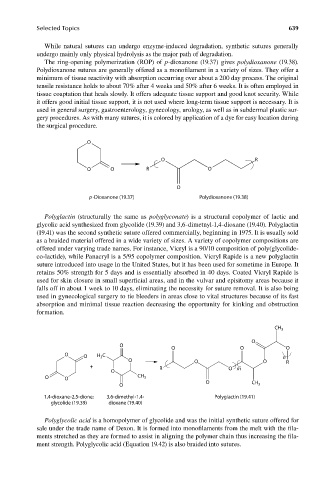Page 676 - Carrahers_Polymer_Chemistry,_Eighth_Edition
P. 676
Selected Topics 639
While natural sutures can undergo enzyme-induced degradation, synthetic sutures generally
undergo mainly only physical hydrolysis as the major path of degradation.
The ring-opening polymerization (ROP) of p-dioxanone (19.37) gives polydioxanone (19.38).
Polydioxanone sutures are generally offered as a monofilament in a variety of sizes. They offer a
minimum of tissue reactivity with absorption occurring over about a 200 day process. The original
tensile resistance holds to about 70% after 4 weeks and 50% after 6 weeks. It is often employed in
tissue coaptation that heals slowly. It offers adequate tissue support and good knot security. While
it offers good initial tissue support, it is not used where long-term tissue support is necessary. It is
used in general surgery, gastroenterology, gynecology, urology, as well as in subdermal plastic sur-
gery procedures. As with many sutures, it is colored by application of a dye for easy location during
the surgical procedure.
O
O R
O O R O
O
p-Dioxanone (19.37) Polydioxanone (19.38)
Polyglactin (structurally the same as polyglyconate) is a structural copolymer of lactic and
glycolic acid synthesized from glycolide (19.39) and 3,6-dimetnyl-1,4-dioxane (19.40). Polyglactin
(19.41) was the second synthetic suture offered commercially, beginning in 1975. It is usually sold
as a braided material offered in a wide variety of sizes. A variety of copolymer compositions are
offered under varying trade names. For instance, Vicryl is a 90/10 composition of poly(glycolide-
co-lactide), while Panacryl is a 5/95 copolymer composition. Vicryl Rapide is a new polyglactin
suture introduced into usage in the United States, but it has been used for sometime in Europe. It
retains 50% strength for 5 days and is essentially absorbed in 40 days. Coated Vicryl Rapide is
used for skin closure in small superficial areas, and in the vulvar and episitomy areas because it
falls off in about 1 week to 10 days, eliminating the necessity for suture removal. It is also being
used in gynecological surgery to tie bleeders in areas close to vital structures because of its fast
absorption and minimal tissue reaction decreasing the opportunity for kinking and obstruction
formation.
CH 3
O
O
O O O
O O H 3 C n
O O O R
+ R O m
O
O O CH 3
O
O CH 3
1,4-dioxane-2,5-dione; 3,6-dimethyl-1,4- Polyglactin (19.41)
glycolide (19.39) dioxane (19.40)
Polyglycolic acid is a homopolymer of glycolide and was the initial synthetic suture offered for
sale under the trade name of Dexon. It is formed into monofilaments from the melt with the fi la-
ments stretched as they are formed to assist in aligning the polymer chain thus increasing the fi la-
ment strength. Polyglycolic acid (Equation 19.42) is also braided into sutures.
9/14/2010 3:44:03 PM
K10478.indb 639 9/14/2010 3:44:03 PM
K10478.indb 639

